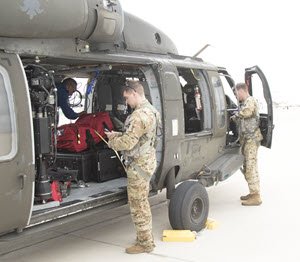Story and Photos by: Spc. Miguel Ruiz, 100th MPAD
 Members of the Texas National Guard and Texas Task Force 1 prepositioned in Laredo, Texas, June 20, 2018, after heavy rains flooded portions of the Rio Grande Valley. The two agencies work together to conduct rescues when needed. (U.S. Army National Guard photo by Spc. Miguel Ruiz)
Members of the Texas National Guard and Texas Task Force 1 prepositioned in Laredo, Texas, June 20, 2018, after heavy rains flooded portions of the Rio Grande Valley. The two agencies work together to conduct rescues when needed. (U.S. Army National Guard photo by Spc. Miguel Ruiz)
Texas Army National Guardsmen and members of Texas Task Force 1 were deployed to South Texas May 20, 2018.
In response to recent flooding in the Texas Rio Grande Valley, rescue swimmers with Texas Task Force 1 (Urban Search and Rescue Team) and TXANG helicopter pilots were mobilized jointly.
Both organizations normally work independently of each other but combine their assets and expertise when flood disasters occur said Anthony Di Marco, a rescue swimmer with TTF1.
“There are not water-rescue components in the National Guard. That’s where we come in,” said Di Marco. “They fly us to where we need to be and help get us in the water or to where the people are who need rescue. It’s a great working relationship.”
The working relationships between the pilots and swimmers are not developed overnight but rather are orchestrated and fine-tuned regularly.
Di Marco said he sets aside his full-time civilian career being a firefighter in Plano, Texas, once a month to train with TXANG helicopter pilots and TTF1 swimmers.
“We rehearse day-time and night-time rescue missions with Lakota and Blackhawk pilots,” said Di Marco. “The back and forth dialogue is great, we work closely together to determine the most efficient and safest ways of conducting the missions.”
Thanks to consistent training and set-in-place contingency plans, mission-readiness is very high when disasters occur said Texas Army National Guard Chief Warrant Officer 4 Brandon Briggs, a Standardization Instructor Pilot of Bravo company, 1-114th Aviation Regiment – Security and Support.
Briggs said that at any given time he, his helicopter crew and TTF1 swimmers can be ready to fly to wherever they are needed within three hours of receiving the call to duty.
“We didn’t have these same capabilities over five years ago,” said Briggs. “Local governments now have in place very specific mission-ready packages put together by the Texas Military Department. Local officials now know exactly how many of what assets are available to them at any given time of need.”
Briggs said what sets the TXARNG apart from other components of the military is its ability to work more closely with Texas’ local governments and organizations such as TTF1 to establish disaster contingency plans.
“It’s our job to be able to respond to events as quickly as possible,” said Briggs. “We are always ready.”